Potřebujeme váš souhlas k využití jednotlivých dat, aby se vám mimo jiné mohly ukazovat informace týkající se vašich zájmů. Souhlas udělíte kliknutím na tlačítko „OK“.
ASTM D5241-92(2011)
Standard Practice for Micro-Extraction of Water for Analysis of Volatile and Semi-Volatile Organic Compounds in Water
Automaticky přeložený název:
Standardní praktiky pro Micro-Těžba vody pro analýzu těkavých a těkavých organických sloučenin ve vodě
NORMA vydána dne 1.5.2011
Informace o normě:
Označení normy: ASTM D5241-92(2011)
Poznámka: NEPLATNÁ
Datum vydání normy: 1.5.2011
Kód zboží: NS-30420
Počet stran: 5
Přibližná hmotnost: 15 g (0.03 liber)
Země: Americká technická norma
Kategorie: Technické normy ASTM
Kategorie - podobné normy:
Anotace textu normy ASTM D5241-92(2011) :
Keywords:
extraction, microextraction, sample preparation, semivolatile, volatile, water, Chemical analysis--water applications, Electron-capture detectors (ECD), Extraction methods, Flame ionization detectors (FID), Inorganic compounds--water, Microextraction, Organic compounds--water, Pentane microextraction, Sample preparation--water applications, Semi-volatile organic/inorganic compounds, Solvent extraction, Volatile matter content--water, Volatile organic compounds (VOC)--water
Doplňující informace
| Significance and Use | ||||||||||||||||||
|
This practice provides a general procedure for the solvent extraction of volatile and semi-volatile organic compounds from a water matrix. Solvent extraction is used as the initial step in the solvent extraction of organic constituents for the purpose of quantifying extractable organic compounds. Typical detection limits that can be achieved using micro-extraction techniques with gas chromatography (GC) with flame ionization detector (FID), electron capture detector (ECD), or with a mass spectrometer (GC/MS) range from milligrams per litre (mg/L) to nanograms per litre (ng/L). The detection limit, linear concentration range, and sensitivity of the test method for a specific organic compound will depend upon the sample clean-up, injection volume, solvent to sample ratio, solvent concentration methods used, and the determinative technique employed. Micro-extraction has the advantage of speed, simple extraction devices, and the use of small amounts of sample and solvents. Selectivity can be improved by the choice of solvent (usually hexane or pentane) or mixed solvents, extraction time and temperature, and ionic strength of the solution. Extraction devices can vary from the sample container itself to commercial devices specifically designed for micro-extraction. See 7.1 and 7.2. |
||||||||||||||||||
| 1. Scope | ||||||||||||||||||
|
1.1 This practice covers standard procedures for extraction of volatile and semi-volatile organic compounds from water using small volumes of solvents. 1.2 The compounds of interest must have a greater solubility in the organic solvent than the water phase. 1.3 Not all of the solvents that can be used in micro extraction are addressed in this practice. The applicability of a solvent to extract the compound(s) of interest must be demonstrated before use. 1.4 This practice provides sample extracts suitable for any technique amenable to solvent injection such as gas chromatography or high performance liquid chromatography (HPLC). 1.5 The values stated in SI units are to be regarded as the standard. 1.6 The values stated in SI units are to be regarded as standard. No other units of measurement are included in this standard. 1.7 This standard does not purport to address all of the safety concerns, if any, associated with its use. It is the responsibility of the user of this standard to establish appropriate safety and health practices and determine the applicability of regulatory limitations prior to use. For specific hazard statements, see Section 9. |
||||||||||||||||||
| 2. Referenced Documents | ||||||||||||||||||
|
Podobné normy:
Historická
1.1.2014
Historická
15.6.2010
Historická
15.6.2012
Historická
1.5.2011
Historická
15.7.2013
Historická
1.1.2013
Odebírejte informace o nově vydaných normách ZDARMA:
Chcete pravidelně odebírat informace o nově vycházejících normách z celého světa a to zcela zdarma?
Přihlašte se k odběru. Vše je velice jednoduché a absolutně ZDARMA.
Na výběr máte vydavatele z celého světa.


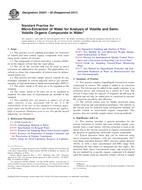
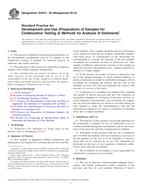 ASTM D3975-93(2014)..
ASTM D3975-93(2014)..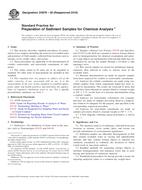 ASTM D3976-92(2010)..
ASTM D3976-92(2010)..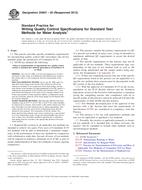 ASTM D5847-02(2012)..
ASTM D5847-02(2012)..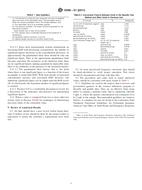 ASTM D596-01(2011)..
ASTM D596-01(2011)..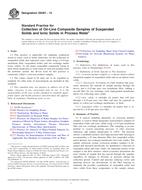 ASTM D6301-13
ASTM D6301-13 ASTM D6362-98(2013)..
ASTM D6362-98(2013)..
 Cookies
Cookies
